Homicide in Scotland 2016-2017: statistics
Statistical bulletin on crimes of homicide recorded by the police in Scotland in 2016 to 2017.
This document is part of a collection
Commentary
Homicide cases
Table 1; Charts 1, 2
- The number of homicide cases recorded by the police in Scotland increased by 5% between 2015-16 and 2016-17, from 58 to 61. This is the same number of cases as in 1990-91 and 2013-14, the joint second lowest annual number of homicide cases since 1976, the first year for which comparable data are available (Chart 1). Since 2012-13 the figures have leveled off to an average of 61 cases a year, following a downward trend since 2004-05.
Chart 1: Cases recorded as homicide by the police, Scotland, 1996-97 to 2016-17
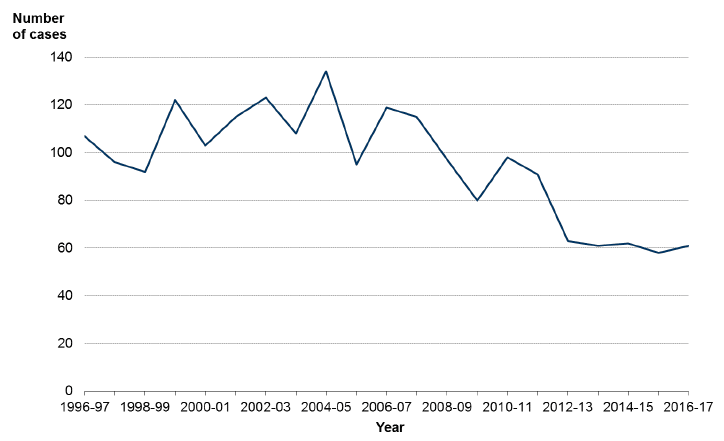
- Homicide cases involving more than one victim are relatively rare, in 2016-17 there were three homicide cases with two victims (Table 1). Of the 61 homicide cases recorded, 11 involved more than one accused person.
Table 1: Summary table of homicide cases, victims and accused persons, Scotland, 2007-08 to 2016-17
| 2007-08 | 2008-09 | 2009-10 | 2010-11 | 2011-12 | 2012-13 | 2013-14 | 2014-15 | 2015-16 | 2016-17 | |
|---|---|---|---|---|---|---|---|---|---|---|
| Total number of cases | 115 | 97 | 80 | 98 | 91 | 63 | 61 | 62 | 58 | 61 |
| Cases by number of victims: | ||||||||||
| 1 | 115 | 95 | 78 | 97 | 90 | 63 | 60 | 62 | 58 | 58 |
| 2+ | - | 2 | 2 | 1 | 1 | - | 1 | - | - | 3 |
| Total number of victims | 115 | 99 | 82 | 100 | 93 | 63 | 62 | 62 | 58 | 64 |
| Cases by number of accused: | ||||||||||
| 1 | 88 | 67 | 53 | 68 | 66 | 45 | 47 | 49 | 48 | 47 |
| 2 | 16 | 19 | 20 | 19 | 13 | 11 | 8 | 9 | 8 | 5 |
| 3+ | 8 | 8 | 6 | 10 | 10 | 6 | 6 | 4 | 1 | 6 |
| unsolved | 3 | 3 | 1 | 1 | 2 | 1 | - | - | 1 | 3 |
| Total number of accused | 149 | 132 | 121 | 142 | 127 | 85 | 90 | 80 | 67 | 77 |
- In 2016-17, Glasgow City had the highest number of homicide cases (12), representing 20% of the Scottish total. Glasgow City has nearly double its share of homicides compared to its population (with 11% of the Scottish population in 2016[3]). It is important to note, however that victims may not necessarily reside in the local authority where the homicide took place. Glasgow City has also witnessed a large fall in homicides of 60% since 2007-08, accounting for one third of the overall national decrease.
Chart 2: Location of homicide cases, where known, Scotland, 2007-08 to 2016-17
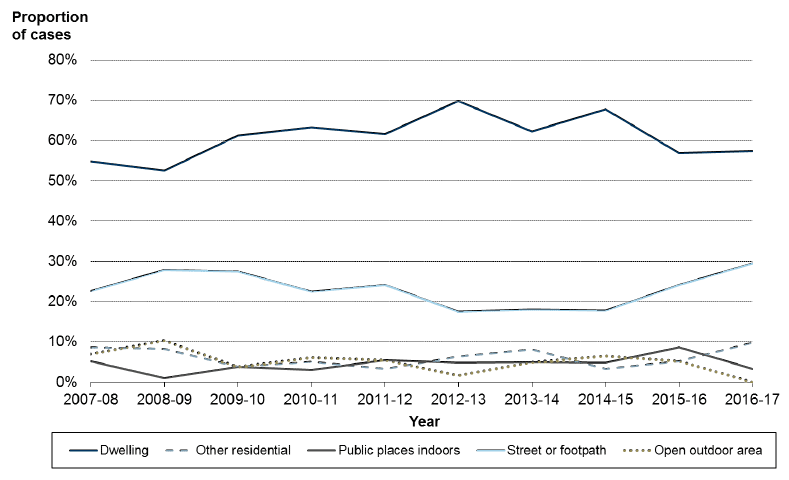
- In 2016-17, 67% of homicides occurred within a residential location (dwelling and other residential), 30% in outdoor public places (street, footpath and open outdoor area) and 3% in indoor public places (Chart 2).
Victims of homicide
Table 5; Charts 3, 4
- Between 2015-16 and 2016-17, the number of homicide victims in Scotland increased by 10%, from 58 to 64. Remaining at a similar level to that seen in the previous four years (Chart 3).
Chart 3: Total number of victims and victims by gender, Scotland, 1996-97 to 2016-17
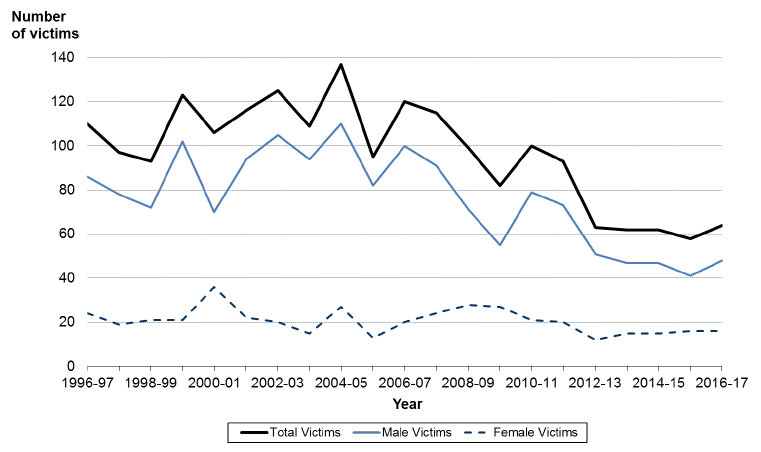
- In 2016-17, there were 48 male victims, representing 75% of all homicide victims. Males are more likely to be victims compared to women, with an overall rate for males of 18 victims per million population, three times the rate for females (six victims per million population).
- Chart 4 shows the victimisation rate by age group and gender for homicides since 2007-08 (i.e. for the past 10 years - representing 798 victims). The victimisation rate is higher for males than for females for all age groups except for individuals aged over 70. The rate for males peaks in the 21 to 30 age group.
Chart 4: Age profile of homicide victimisation rate by gender, Scotland, 2007-08 to 2016-17
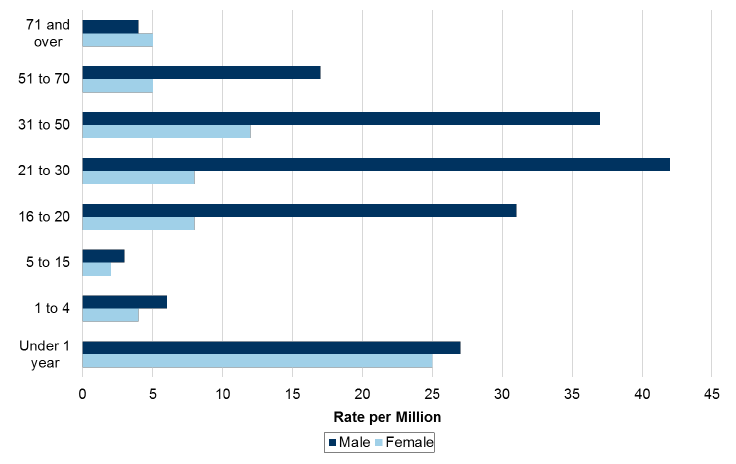
Persons accused of homicide
Table 6; Charts 5, 6
- The number of people accused of homicide has shown an overall downward trend since 2004-05 (Chart 5). In 2016-17, there were 77 persons accused of homicide, 10 more than in 2015-16 and the second lowest number since 1976, the first year for which comparable data are available.
- The vast majority of persons accused of homicide since 1996-97 have been male, making up 88% of all accused in 2016-17.
Chart 5: Total number of accused and accused by gender, Scotland, 1996-97 to 2016-17
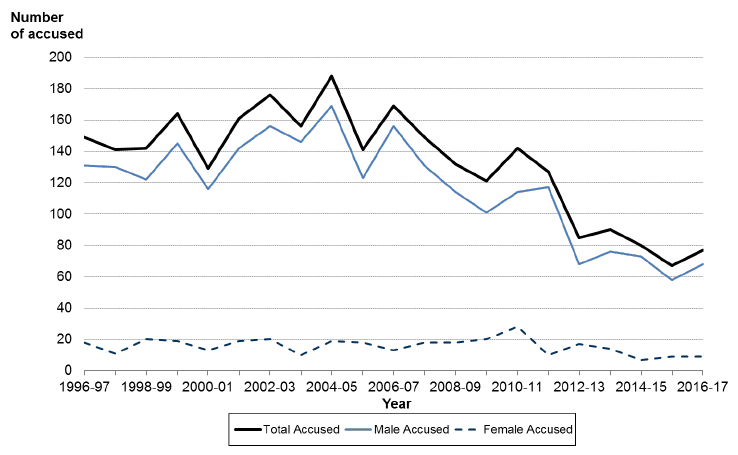
- In 2016-17, the total number of individuals accused of homicide equated to 14 per million population. This is the second lowest rate recorded in the last ten years.
- In 2016-17, for both males and females, the rates for those accused of homicide were highest for the 16 to 20 age group, at 75 per million population and 13 per million population respectively.
- Chart 6 shows the rate for accused by age group and gender for homicides since 2007-08 (i.e. for the past 10 years - representing 1,070 accused). The rates for males accused of homicide per million population were considerably higher across all age groups than for females.
Chart 6: Age and gender profile of persons accused of homicide per million population, Scotland, 2007-08 to 2016-17
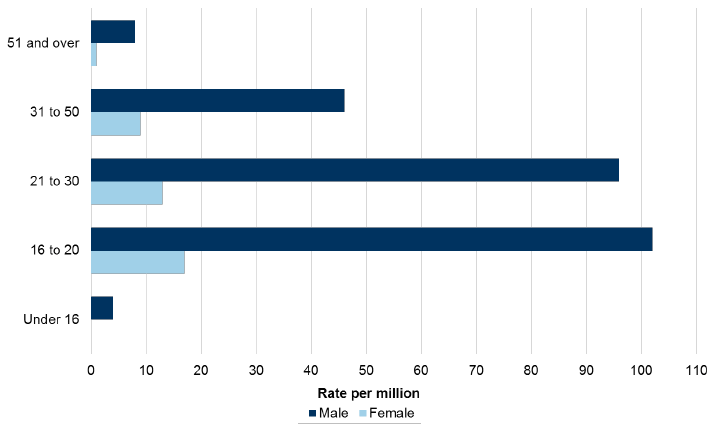
Method
Table 7; Chart 7
- Chart 7 shows that the most common main method of killing in each of the last ten years was with a sharp instrument. This includes 50% (32)[4] of homicide victims in 2016-17 of which all but two involved a knife. The next most common main method was hitting and kicking, accounting for 17% (11) of homicide victims in 2016-17.
- Homicide by shooting is relatively rare in Scotland. In 2016-17 there was only one victim recorded and since 2007-08 there have only been two years where more than two victims were recorded.
Chart 7: Victims of homicide by main method of killing, 2007-08 to 2016-17
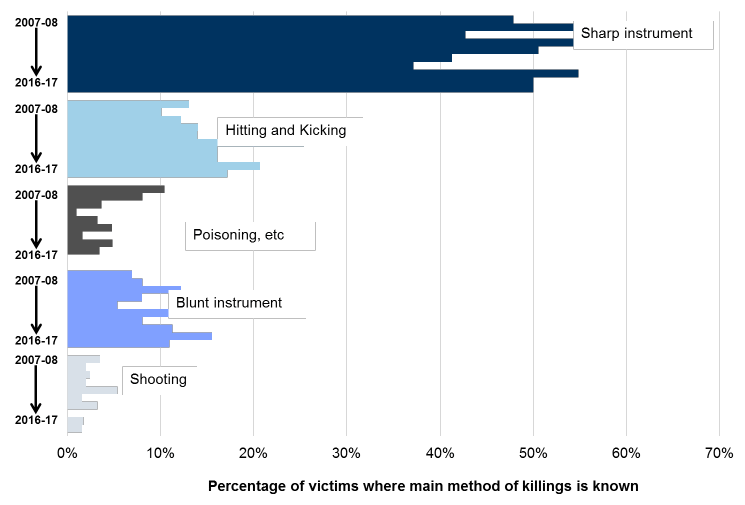
Relationship of main accused to victim
Tables 8-10; Charts 8-10
- In the majority of cases, the victim and main accused were known to each other, representing 67% of homicide cases solved in 2016-17. The accused was unknown to the victim in 18 cases (30%). This latter group includes 12 cases where the victim was not known to the accused and six cases where the victim was known to the accused. Of those cases where the victim and accused were known to each other, 68% were acquaintances, 18% were relatives and 15% were partners or ex-partners. The relationship to the main accused was unknown in the remaining 3% of cases.
- Chart 8 and Chart 9 show the percentage of homicides for male and female victims by their relationship to the main accused since 2007-08. Male victims were consistently most likely to be killed by an acquaintance. Until 2014-15, female victims were generally more likely to be killed by a partner or ex-partner. However, in recent years as the number of female victims has decreased (16 in 2016-17 compared with 24 in 2007-06) there has been greater year-on-year fluctuation in the proportions of the accused's relationship to the victim.
- Between 2007-08 and 2016-17 a total of 39 children under the age of 16 years were victims of homicide (where there was an accused person). Of these, 74% were killed by one of their parents. Since 2007-08 there have been 15 victims aged under one year old and in all but two cases (where there was an accused person) the main accused was a parent.
Chart 8: Male victims of homicide by relationship to main accused, where relationship known, Scotland, 2007-08 to 2016-17
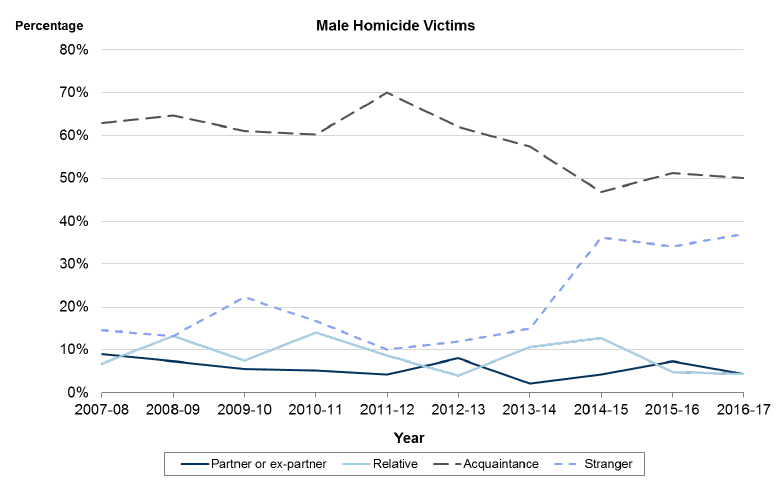
Chart 9: Female victims of homicide by relationship to main accused, where relationship known, Scotland, 2007-08 to 2016-17
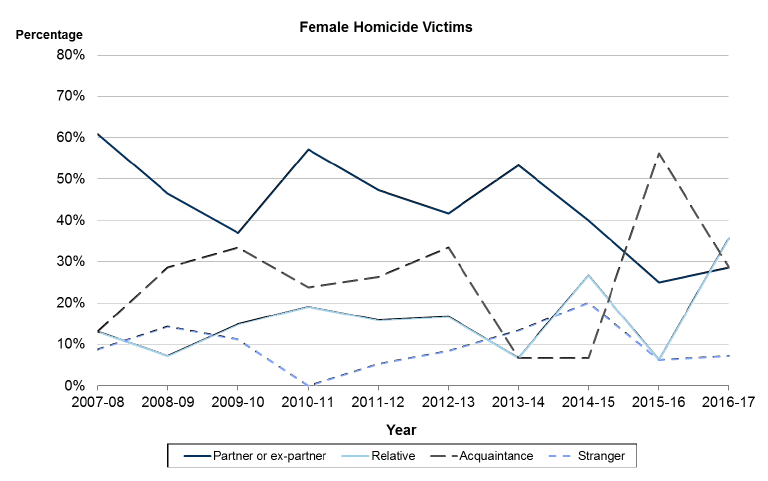
- For all homicides recorded in the last ten years, just over half (52%) of the female victims aged between 16 and 70 years were killed by their partner or ex-partner, 28% were killed by an acquaintance and 8% were killed by a stranger. For male victims aged 16 to 70 years, only 6% were killed by their partner or ex-partner. Just under two thirds (62%) of male victims aged 16 to 70 years were killed by an acquaintance and 20% were killed by a stranger.
- Of the 25 people aged over 70 who were victims of homicide between 2007-08 and 2016-17, 16 were female and nine were male. Older people were most likely to be killed by an acquaintance (seven victims, of which five were male). Of the six victims killed by their son or daughter, five were female.
- Chart 10 shows that two-thirds of all homicide cases (66%) recorded between 2007-08 and 2016-17 involved males killing males. Cases where the main accused and main victim were both female accounted for just 3% of the total number.
Chart 10: Relationship between main accused and victim by gender, where relationship known, Scotland, 2007-08 to 2016-17
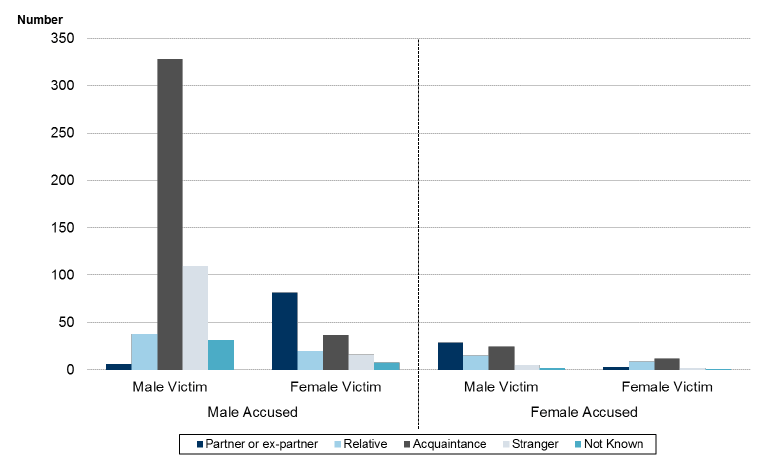
Main motive
Tables 11 -14
- The most common reasons recorded for committing homicide in the ten year period between 2007-08 and 2016-17, were fight or quarrel, and rage or fury, with just over half (51%) of all victims in solved cases killed in such circumstances. In 2016-17, this figure was 40% (24 victims), with a slightly smaller proportion for female (36%) compared with male (41%) victims.
- In the period 2007-08 to 2016-17, 80% of all female victims were killed in dwellings, compared with 54% of males. The most likely set of circumstances in which females become victims of homicide are in a dwelling, in a rage or fight with a partner or ex-partner (21% of female victims). Location is less of a factor for male victims, whose killings are typically a result of a rage or fight with an acquaintance either in a dwelling (19% of male victims) or not in a dwelling (15% of male victims).
- Twenty-one victims were reported to have been killed in drug-related homicide cases in 2016-17, of which 19 were male. None of the homicides recorded in 2016-17 were reported to have had a homophobic motivation and two were reported to have had a racial motivation. In all homicide cases in the ten years leading up to 2016-17, 2% had a homophobic or racist motivation.
Use of alcohol and drugs
Tables 13, 15-18; Chart 11
- Of the 77 persons accused in homicide cases in 2016-17, 22 (29%) were reported to have been under the influence of alcohol, drugs or a combination of both at the time of the homicide. Of these, 15 (19%) were under the influence of alcohol, five (6%) were under the influence of both alcohol and drugs and two (3%) were under the influence of drugs alone.
- In 2016-17, the alcohol and drug status of the accused was unknown for 47 persons, 61% of all accused. Eight accused persons (10%) were reported to have been neither under the influence of alcohol nor drugs at the time of the homicide.
- In the ten year period between 2007-08 and 2016-17, around half (47%) of all accused were reported to have been under the influence of alcohol and/or drugs at the time of the homicide. This is similar for both males (47%) and females (45%).
- Chart 11 shows that over the last ten years 24% (107) homicides, where the accused was suspected of being under the influence of alcohol, occurred on a Saturday. Furthermore, nearly three fifths of homicides where the accused was under the influence of alcohol (59% or 268) occurred during the weekend (i.e. Friday, Saturday and Sunday).
Chart 11: Distribution of the accused of homicide under the influence of alcohol[5] by day of the week 2007-08 to 2016-17
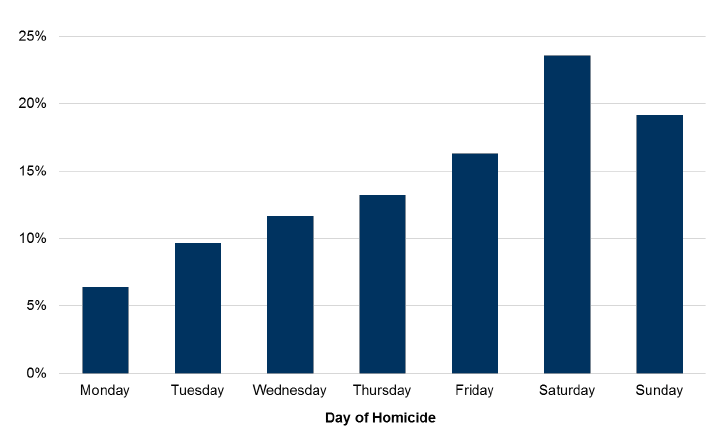
Comparator statistics
Table 4; Chart 12
- This bulletin has reported a decreasing trend in homicides over the longer term. Chart 12 shows this trend and compares it to the trend in attempted murder and serious assaults. This latter information is taken from the Recorded Crime in Scotland, 2016-17 bulletin. Over the ten year period between 2007-08 and 2016-17, the reduction in levels of homicide has broadly followed a similar fall in levels of attempted murder and serious assault.
Chart 12: Indices in selected crimes of violence, Scotland, 2007-08 to 2016-17 (Index 2007-08 = 100)
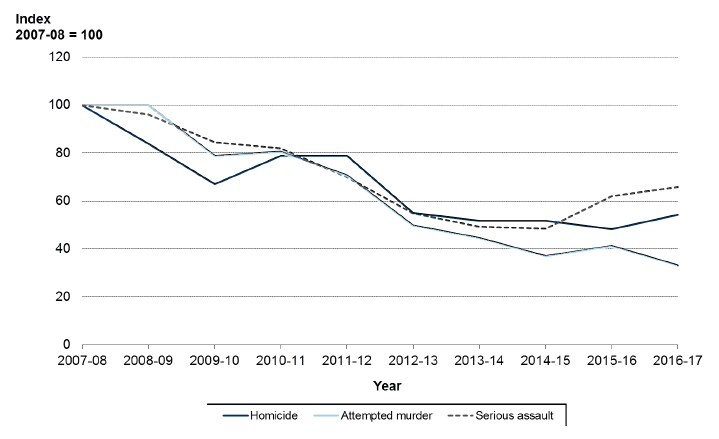
- Chart 13 uses an index to evaluate the trends in homicide victimisation rates in Scotland and England & Wales[6] between 2007-08 and 2016-17 (Note that 2016-17 England & Wales data are not yet available). Direct comparisons with England & Wales are not possible due to uncertainty around different counting and classification conventions. However we can compare the change over time, which is broadly similar to the downward trend in Scotland since 2007-08.
Chart 13: Change in the victimisation rate in Scotland (2007-08 to 2016-17) and England and Wales (2007-08 to 2015-16) (Index 2007-08 = 100)
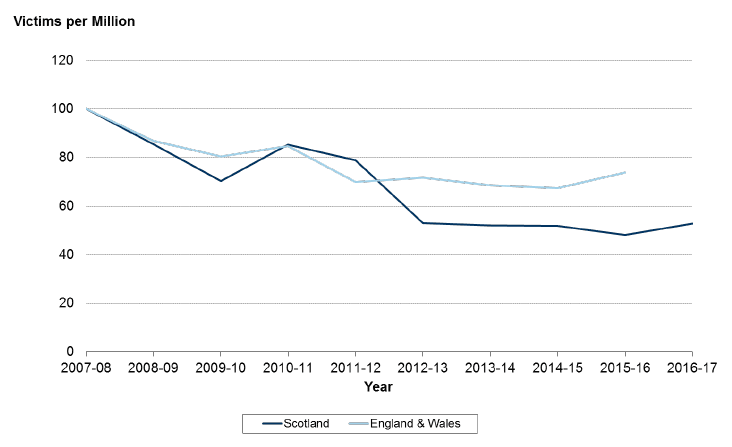
Contact
Email: Mark Bell
There is a problem
Thanks for your feedback